Note: See glossary for meaning of terms marked in bold below.
Just getting to Likir and back was a mild adventure where we ran into multiple obstacles. But we happened to be there at the right time to witness the rituals in a special puja.
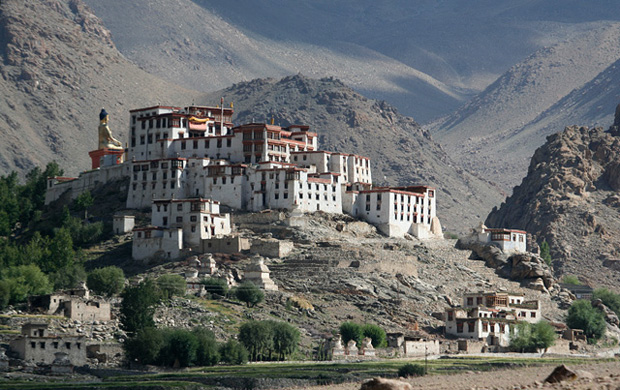
We got caught in high speed winds as soon as we left Leh in a rented two-wheeler. It seemed like a passing thing at first, but the strong winds kept our company for the next fifteen minutes. It was never too strong and threatening enough to blow us away, but had the strength to throw every bit of dust and dirt towards us. It was a tortuous ride against the wind, allowing me to go at speeds no more than ten to fifteen kilometers per hour. In a small stretch where we had to drive close to Indus, the gale lifted the river’s waters and splashed on us generously with great force.
Worried and stuck in the middle of the storm, I looked around for alarmed people who would be searching for a shelter. A jeep passed in the opposite direction, their occupants looking so calm as though they did not notice anything abnormal. A man riding a scooter came from behind and did not appear troubled either. ‘This must be normal,’ I told myself, and let go of the thoughts of searching for a shelter or thinking of heading back.
It was late evening before we approached the mountains near Likir, riding past the confluence of Indus and Zanskar in Nyemo (also written as Nimmu, Nimu, Nimo, Nimmo and every other possibility you can arrive at, keeping N in the beginning and m as the next consonant!) and the precariously perched Basgo Monastery. We missed our turn to Likir, as the only sign at the fork advertised a guesthouse and gave away no other information. Treading an extra five kilometers and realizing the folly after arriving at Saspol Village, we headed back and turned into the right track to arrive at Likir in darkness.
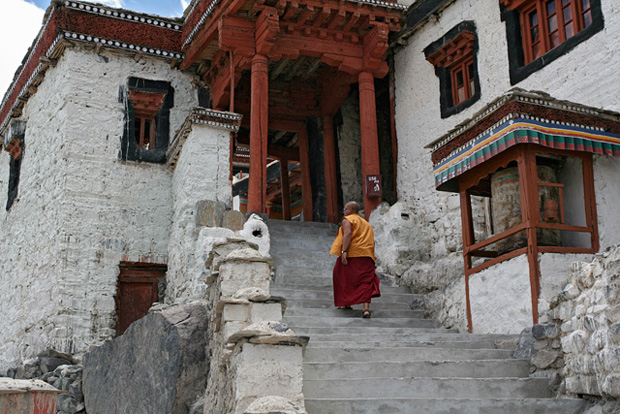
Next morning, we left the bike behind and walked through the village and its barley fields to the monastery at the far end of the village. What seemed to be a short walk stretched longer and longer in the hot sun, tiring my unprepared mind and body. Likir Monastery is a cluttered assembly of buildings surrounded by willow trees on a crag. A stream runs at the base of the crag, originating from the taller ica-capped mountains beyond the monastery. At a corner of the monastery is a tall statue of Buddha that shines brightly in the sun.
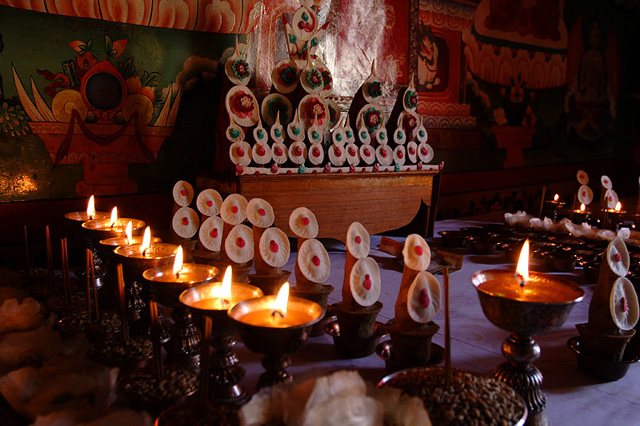
The monastery looked empty at first, until I saw the dukhang filled with ochre robed monks of all ages getting ready for a special puja to install a Yamantaka Mandala. The prayer hall was decorated with lines of torma and oil lamps for the puja. The puja was elaborate process, with all the monks gathered in dukhang and chanting together for a few hours. They begin with their regular ochre robe, slipping in another layer of cloth a little later. An ornate headgear gets added soon, which gets replaced later with the traditional yellow-hat of the drukpa lineage. Chanting continues all through, accompanied with hand movements making various mudras and gestures. The puja is finally concluded by returning to their original robes.
While all this goes on, the little monks sitting in a separate row behave the way kids should be. Some naughty kids begin play-fight with neighbours. Some of them look bored and lost in a world of dreams. One of the brats gets up in the middle and requests to be excused, but he is gently ordered to get back to his seat.

Back from the monastery in the evening, the adventures of the journey continued as we discovered that the bike’s rear tyre is punctured. The attempt to get the punctured bike back to Leh deserves another chapter altogether.
Information
The monastery at Likir is among the best maintained monasteries in Ladakh. One of the special features of the monastery is the 3-storey high statue of Buddha.
How to reach. Likir is about 50km from Leh. You can hire cabs in Leh to take you there. It should be possible to combine your visit to Likir with Alchi. If you have the time, visit the confluence of Indus and Zanskar at Nyemo on the way. Another worthwhile stopover is the fort and monastery at Basgo, which falls on the way. Public transport is available from Leh to Likir. But inquire in advance, as the buses may leave you at the village, which is an hour’s walk from the monastery.
Food and accommodation. There are many guesthouses spread along the village of Likir, but most of them are about 30 to 60 minutes walk from the monastery. Options for food are limited but available. Most guesthouses cater to their occupants.
Map and driving directions
View Leh to Likir in a larger map
I went to Alchi Monastery looking for the ancient paintings of a distinct style that sets it apart from other religious centers in Ladakh. Trees laden with apricots and the swift flowing Indus River were an added bonus.
My bus passed through lush green oasis of saspol village on its way to Alchi. After two hours on the road west of Leh along the Indus River, the bare mountainscape temporarily made way for a relatively flat terrain teeming with apricots and apples amidst barley fields. The apricots trees with numerous fruits looked more yellow than green. Apple trees were irresistibly red.
Just across the river, Alchi Village has one of the oldest standing structures anywhere in Ladakh. The Alchi choskor or the ‘religious enclave’ is dated approximately to eleventh century and has an architecture very unlike other monasteries in the region. It was abandoned as a place of worship and remained unknown to rest of the world, till historians unearthed the treasured paintings in the choskor only a few decades ago. On hindsight, its desertion seems to have worked well in its preservation. The monastery escaped destruction from Kashmiri invaders four centuries years ago as much as it escaped renovation and restoration from the Ladakhi monks.
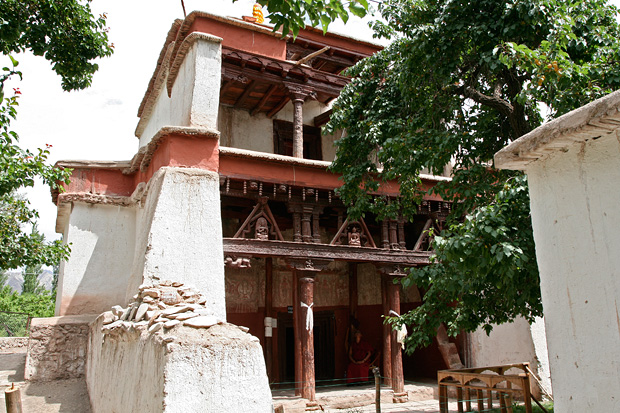
Sum Tsek at Alchi Monastery
Walking past the small village and along a narrow path on the banks of Indus, I entered the monastery that wore a deserted look. It did not have the usual buzz of playful kid-monks running along the corridor chasing each other or the smiling elderly lamas in ochre robes walking slowly as they chanted some mantra. Also missing were the randomly built living quarters that usually spread around the prayer hall, the quadrangle where the festivals are held and the colourful paintings on the front walls. The choskor looked more like a bunch of randomly built houses with a few apricot trees surrounding them.
The drab exteriors though, are a contrast to the colourful inner walls. Once inside, I see every inch of the wall covered with small paintings. The sum-tsek—the main temple in Alchi—is a three story building with colourful paintings in its inner walls. It takes some time to get used to the interiors kept dark to preserve the paintings. The colours start coming alive as the eyes slowly get accustomed to the darkness. The walls are covered from end to end with thousands of small colourful images of Buddha. At the center of three inner walls are three-story high statues of incarnations of Buddha—Avalokiteshwara, Maitreya and Manjushree. The upper half of the Buddha statues are not visible from below, as they stand above the first floor where the weakening structure doesn’t permit access.
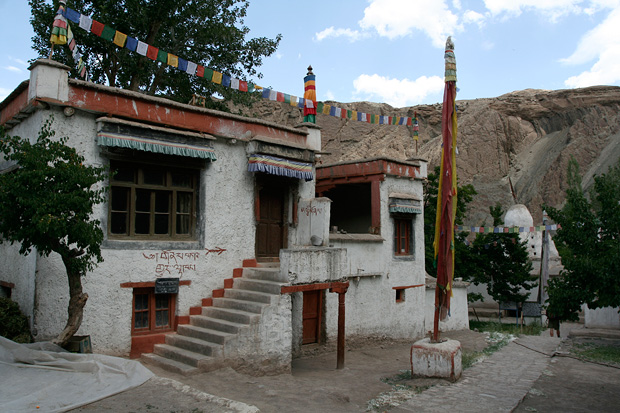
A section of the monastery
At the neighbouring prayer hall are equally colourful but a diverse variety of paintings that include a sailing ship, people wearing clothes that look Central Asian and other secular images that are evidently not Ladakhi. The paintings in Alchi vary considerably from other monasteries influenced by Tibetan culture and its animist origins. It doesn’t carry the extraordinary characters and stylization with demonic and unearthly features commonly seen on the walls of most other monasteries. On the contrary, they are said to bear resemblance to Buddhist paintings from the Indian plains, indicating that Alchi was perhaps built in a time when a wave of Buddhist preachings spread into Ladakh from Kashmir and North India. Historians often refer to this as ‘second spreading of Buddhism’ against the first arrival of the religion in Ladakh from Tibet. Among the Himalayan Buddhist centers, only other surviving monastery with paintings similar to Alchi are found in Tabo Village in Lahaul and Spiti. Both monasteries are now in the tentative list of UNESCO World Heritage sites.
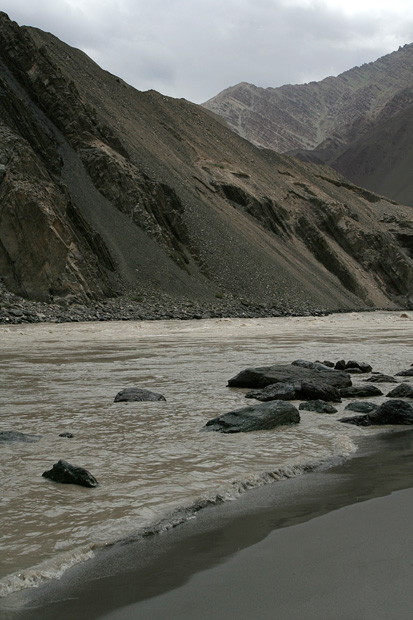
Just outside the monastery, Indus River flows swiftly in a depression carved by its currents. I walked down to the river bank and spent some time watching its fast flowing muddy current before making my way back to Leh in the evening.
Information
The Alchi choskor complex has five buildings. The sum-stek or the three story temple has three-story high statues of Avalokiteshwara, Maitreya and Manjushree, with its walls painted with thousands of small Buddhas. The dukhang or the main prayer hall is larger with two sections and has many secular and religious paintings. The Manjushri Lhakhang, Lotsawa Lhakhang and Lhakhang Soma are the smaller temples.
Alchi Monastery is known for the historical value and uniqueness of the paintings. It is no longer in use as a religious place, though it is maintained and managed by the monks of nearby Likir Monastery.
How to reach. Alchi is 65km from Leh downstream Indus. Most tourists hire a cab to get there, though Alchi is well connected by public transport from Leh (about 3 hours). If you are taking a bus from Leh, it is better to be informed about the timings beforehand. Ask your hosts in Leh or check at the bus-stand a day before.
Food and Accommodation. If you are on a day-trip from Leh, Alchi Village has a few restaurants just outside the monastery. In front of the the choskor is a place run by Likir Monastery, where food and accommodation is available. There are a few more guesthouses and hotels available in Alchi for those who would like to stay at the village.
Map and driving directions.
View Leh to Alchi in a larger map
This is a guest post by Priyanka Dalal about her visit to religious centers in and around Nasik. Priyanka writes at priyankawriting.com. Photographs are courtesy of the author.
After a four-hour drive from my house in South Mumbai, I found myself approaching Nasik city. Spending a day there, I was surprised at the myriad host of religious places that the city has. Here are some of them to give you an idea about what a multi-religious fanfare this small city close to Mumbai really is.
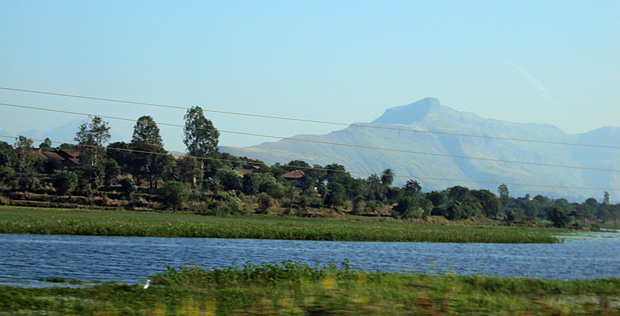
On the road to Nasik
Shahapur Manas Mandir: My destination in Nasik was a Jain Tirth called Shahapur Manas Mandir. It is a newly built religious place – a huge, beautifully carved temple with lots of small idols placed in sanctuaries of their own, including a snake god (Kshetrapalji) temple below a huge banyan tree. This temple complex is situated on a small hill. Below the hill is a stay and dining area, a lake and a place for Jain monks to stay.
If you take a train from Mumbai, go from CST to Asangaon (takes about 45 minutes in a fast train). A rickshaw from Asangaon, takes 15 minutes to drop you at the Mandir.
Dharmachakra: A little ahead of Shahapur village is another Jain Tirth called Dharamachakra. Dharmachakra has many sculptures and carvings, many of them depicting other Jain holy places. It is located right by the Mumbai-Nasik highway 15 minutes away from the city. Along with the temple is a stay and dining area. Women must wear a salwar kameez to enter the bhojanalaya (dining hall) and the temple. However, they lend Salwar Kameez to those who are not carrying one.
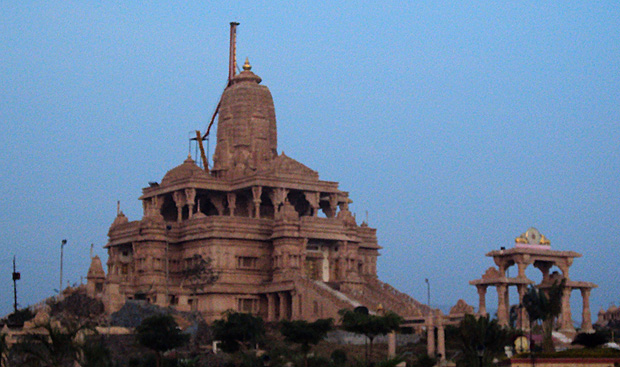
Buddha Vihar: A 15 minutes walk from Dharmachakra, Buddha Vihar is a dome shaped meditation hall constructed by the Nasik city corporation. The Vihara has a huge Golden Buddha Idol in a hall where many people sit and meditate. A tape usually keeps playing in the background with the chants of “Buddham Sharanam Ghachchami, Sangham Sharanam Gachchami, Dhammam Sharanam Gachchami”. Its a soothing and quiet place, but can get noisy on Sundays.
The lawn around the Buddha Vihar is a good place to spend some time in, lie down or picnic with family. A short trek from the lawn up a hill takes you to caves that are said to have served as the abode of the Pandava brothers.
Panchvati: Inside Nasik city is a place with 5 Banyan trees. The lore says this is where Rama and Sita rested. There is also a cave nearby. However, the area now has a commercialized look.
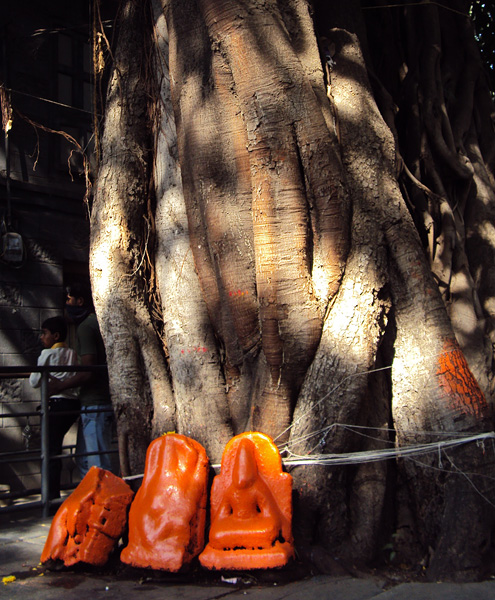
At Panchavati
Nasik is surrounded by many prominent religious places. During our drive, we came across a large group of people walking along the highway, many of them wearing no footwear. They were on a walking pilgrimage to Shirdi, two hours beyond Nasik by car or bus.
Nasik is also not far from Dhammagiri with its Vipassana Research Institute, which conducts meditation courses. About 20km from Buddha Vihar is Trimbakeshwar, one of the twelve Jyothirlingas. Jyotirlingas are powerful, consecrated lingas that are believed good for spiritual and all round well-being.
There are many smaller temples and religious centres in and around Nasik. Other things to see around Nasik include the vineyards, including the well known Sula vineyards is just outside Nasik.









